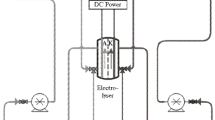Abstract
The iron- and copper-based Fenton (-like) reactions produce high-valent metal species (ferryl and cupryl ions). Ferryl and cupryl ions as reactive oxidants are capable of oxidizing refractory organic compounds in water. Ferryl and cupryl ions can be used for the inactivation of microorganisms in both planktonic and biofilm states.
You have full access to this open access chapter, Download conference paper PDF
Similar content being viewed by others
Keywords
The iron- and copper-based activation of oxygen and hydrogen peroxide via the Fenton (-like) reactions produce high-valent metal species such as ferryl and cupryl ions (i.e., Fe(IV) and Cu(III)). The high-valent metal species are less reactive than hydroxyl radical, but still, they are strong oxidants (Eo[M(ν+1)+/Mν+] = ca. 1.5–2.5 VNHE) capable of oxidizing refractory organic compounds in water. These reactive oxidants can be used in the oxidative degradation of organic contaminants as well as in the inactivation of harmful microorganisms. In spite of recent advances in the chemistry of high-valent metal species, limited information is available about the reactivity of these oxidants with organic compounds and the mechanisms through which organic compounds are oxidized in the reactions. In addition, the studies on the microbial inactivation using high-valent metal species are rare.
Our recent studies investigated the nature and reactivity of Fe(IV) and Cu(III) produced by different iron- and copper-based Fenton (-like) reactions, and assessed the potential of these oxidants for the degradation of organic contaminants and the inactivation of microorganisms (Kim et al. 2015a, b; Lee et al. 2016, 2017). It was found that the reactivity of Fe(IV) and Cu(III) vary with their forms; Fe(IV) and Cu(III) usually exist as coordination complexes, and the coordinating ligand affects the reactivity of these complexes. Fe(IV) and Cu(III) degraded different organic contaminants via selective and non-selective reactions, depending on the reactivity of Fe(IV) and Cu(III). In addition, Fe(IV) and Cu(III) effectively inactivated microorganisms in both planktonic and biofilm states.
References
Kim, H.-H., Lee, H., Kim, H.-E., Seo, J., Hong, S. W., Lee, J.-Y., et al. (2015a). Polyphosphate-enhanced production of reactive oxidants by nanoparticulate zero-valent iron and ferrous ion in the presence of oxygen: Yield and nature of oxidants. Water Research, 86, 66–73.
Kim, H.-E., Nguyen, T. T. M., Lee, H., & Lee, C. (2015b). Enhanced inactivation of Escherichia coli and MS2 coliphage by cupric ion in the presence of hydroxylamine: Dual microbicidal effects. Environmental Science and Technology, 49, 14416–14423.
Lee, H., Lee, H.-J., Seo, J., Kim, H.-E., Shin, Y. K., Kim, J.-H., et al. (2016). Activation of oxygen and hydrogen peroxide by copper(II) coupled with hydroxylamine for oxidation of organic contaminants. Environmental Science and Technology, 50, 8231–8238.
Lee, H.-J., Kim, H.-E., & Lee, C. (2017). Combination of cupric ion with hydroxylamine and hydrogen peroxide for the control of bacterial biofilms on RO membranes. Water Research, 110, 83–90.
Author information
Authors and Affiliations
Corresponding author
Editor information
Editors and Affiliations
Rights and permissions
Copyright information
© 2020 Springer Nature Switzerland AG
About this paper
Cite this paper
Lee, C. (2020). Use of High-Valent Metal Species Produced by the Fenton (-like) Reactions in Water Treatment. In: Naddeo, V., Balakrishnan, M., Choo, KH. (eds) Frontiers in Water-Energy-Nexus—Nature-Based Solutions, Advanced Technologies and Best Practices for Environmental Sustainability. Advances in Science, Technology & Innovation. Springer, Cham. https://doi.org/10.1007/978-3-030-13068-8_21
Download citation
DOI: https://doi.org/10.1007/978-3-030-13068-8_21
Published:
Publisher Name: Springer, Cham
Print ISBN: 978-3-030-13067-1
Online ISBN: 978-3-030-13068-8
eBook Packages: Earth and Environmental ScienceEarth and Environmental Science (R0)




